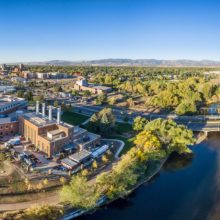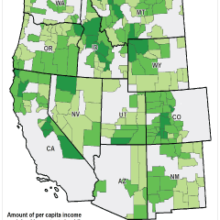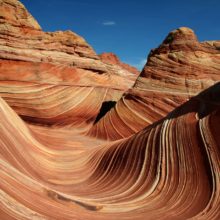- This post summarizes a wide variety of research on the economic value of public lands in the West—whether BLM, Forest Service, or National Parks—to nearby communities.
- Today, rural counties in the West with more federal lands or protected federal lands are performing better on average than their peers with less federal lands or protected federal lands in four key economic measures.
- While every county has its own set of unique circumstances, numerous studies have concluded that protected federal public lands in the West, including lands in non-metro counties, can be an important economic asset that extends beyond tourism and recreation to attract people and businesses.
The resources below are organized in terms of:
Trends | Tools | Regional Studies | Library and Other Research.
Trends
Federal Lands in the West: Liability or Asset?
This report shows that rural counties in the West with more federal lands or protected federal lands performed better on average than their peers with less federal lands or protected federal lands in four key economic measures.
Today’s Economy and the Role of Federal Public Lands
This extensive public lands slideshow (PDF) outlines the economic role of federal lands in today’s economy and the importance of public lands in rural development.
Protected Lands and Economics: What Research and Careful Analysis Say About the Economic Impact of Protected Lands
This research overview analyzes a variety of scientific research on the economic impact of protected lands to nearby communities, especially in the West.
Economic Impact of National Parks on Nearby Communities
This interactive shows how national parks can play an important economic role for local communities; and lists visits, non-local spending, and the number of jobs created in communities for each National Park Service unit.
National Monuments and Surrounding Counties
This series of reports and related interactive map focuses on the economic performance of western communities near national monuments.
Three Wests: Access to Markets Affects Performance
This research and interactive show how there are three distinct types of counties in the West—Metro, Connected, and Isolated—defined by their access to major markets and population centers. A peer-reviewed technical paper was published in the Journal of Rural Studies.
The Economic Benefits of the Land and Water Conservation Fund
This analysis along with an interactive national map summarizes LWCF program benefits–such as access, recreation, water or working lands–for every state from 2011-2014.
Economists Urge Protecting Federal Public Lands
More than 100 economists and academics wrote the President urging him to create and invest in new federal protected lands such as national parks, wilderness, and monuments.
West Is Best: Protected Lands Promote Jobs and Higher Incomes
This report finds that the West’s popular national parks, monuments, wilderness areas and other public lands offer its growing high-tech and services industries a competitive advantage.
The Effect of Protected Federal Lands on Economic Prosperity in the Non-Metropolitan West
This peer-review research paper, published in the Journal of Regional Analysis and Policy, looks at protected lands and economic measures such as per capita income. We created an interactive map based on the research, which showsshowing the amount of per capita income explained by protected federal lands for each county in the non-metropolitan western U.S.
Tools
Economic Profile System (EPS)
This Headwaters Economics tool allows users to produce free, detailed socioeconomic reports at the community, county or state level. EPS reports include topics such as Land Use and Public Land Amenities as well as Agriculture, Timber, or Mining.
National Forests
A national dataviz that can create reports showing the socioeconomic conditions of communities surrounding National Forests.
Protected Lands and Per Capita Income
This interactive map shows the amount of per capita income explained by protected federal lands for each county in the non-metropolitan western U.S.
West-Wide Economic Atlas
Explore the socioeconomic trends and land ownership for every county or state in the western United States.
Explore the Urbanization of the West
Despite being known for its rural landscapes, the West is surprisingly urban. This interactive shows the share of state residents living in metro counties. Rural counties, which hold the great majority of western public lands, contain less than five percent of the West’s population.
Regional Studies
A small sample of regional studies. Search our web or contact us for additional research.
The Economic Potential of Protecting a New Maine National Park
These two reports study the economic costs and benefits of a new National Park and Recreation Area for Penobscot and Piscataquis Counties, Maine. [Note: This region was designated the Katahdin Woods and Waters National Monument in 2016.]
The Economic Value of Public Lands Around Grand County, Utah
This study analyzes the economic role that public lands near Grand County, Utah play in the region.
Economic Opportunities in Wheeler County, Oregon
This report reviews local demographic and economic trends and discusses the challenges facing rural and remote public lands economies and strategies to build economic strength in this context.
Montana’s Economy, Public Lands, and Competitive Advantage
This report summarizes Montana’s economy, analyzing how it has grown and what is driving its performance, including a description of how federal lands help attract people, investment, and businesses.
The Tongass Transition Framework: A New Path Forward?
An analysis examiningwhether the Tongass Transition Framework, which proposed a “new path forward,” is working to enhance economic opportunities in southeast Alaska while conserving the National Forest.
The Economic Impacts of Restoration in Central Idaho
This study calculates the economic impacts of natural resource restoration activities to nearby communities.
Economy of the Olympic Peninsula
This report analyzes the economy of the Olympics Peninsula and impact of the Wild Olympics proposal.
Oregon’s Owyhee Canyonlands
An initial analysis of the potential economic impact of protecting the Owyhee Canyonlands area in Malheur County, Oregon
Montana’s Rocky Mountain Front
This report studies the Front’s land, people, and economy, how the region has changed in important ways during the past several decades, and the potential impact of the proposed Rocky Mountain Heritage Act on the Front.
Gateways to Yellowstone: Protecting the Wild Heart of Our Region’s Thriving Economy
This paper synthesizes four studies on the economy of Yellowstone National Park’s gateway region.
Library of Other Research on the Value of Public Lands
Annotated Bibliography: Studies on the Economic Value of Public Lands and Protected Public Lands
This nine page summary lists research that has appeared in the peer-reviewed academic literature.
Economic Change in the American West: Solutions to the Downside of Amenity Migration
This paper was presented by Ray Rasker in 2008 at the Banff Conference on “Understanding and Managing Amenity-Led Migration in Mountain Regions.”
An Exploration Into the Economic Impact of Industrial Development Versus Conservation on Western Public Lands
This paper, available upon request from Ray Rasker, was published in the Journal of Society and Natural Resources in 2006 (19:191-207).





